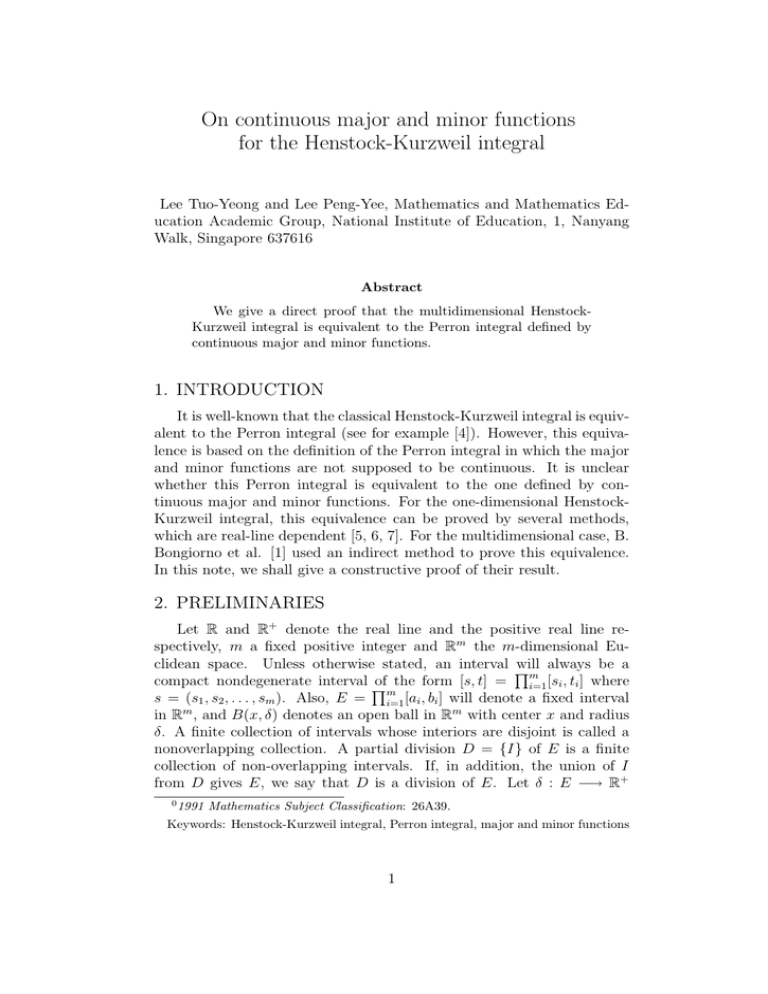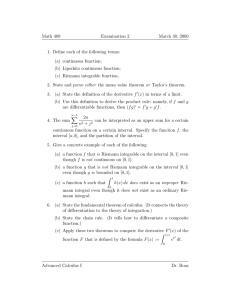On continuous major and minor functions for the Henstock-Kurzweil integral
advertisement

On continuous major and minor functions
for the Henstock-Kurzweil integral
Lee Tuo-Yeong and Lee Peng-Yee, Mathematics and Mathematics Education Academic Group, National Institute of Education, 1, Nanyang
Walk, Singapore 637616
Abstract
We give a direct proof that the multidimensional HenstockKurzweil integral is equivalent to the Perron integral defined by
continuous major and minor functions.
1. INTRODUCTION
It is well-known that the classical Henstock-Kurzweil integral is equivalent to the Perron integral (see for example [4]). However, this equivalence is based on the definition of the Perron integral in which the major
and minor functions are not supposed to be continuous. It is unclear
whether this Perron integral is equivalent to the one defined by continuous major and minor functions. For the one-dimensional HenstockKurzweil integral, this equivalence can be proved by several methods,
which are real-line dependent [5, 6, 7]. For the multidimensional case, B.
Bongiorno et al. [1] used an indirect method to prove this equivalence.
In this note, we shall give a constructive proof of their result.
2. PRELIMINARIES
Let R and R+ denote the real line and the positive real line respectively, m a fixed positive integer and Rm the m-dimensional Euclidean space. Unless otherwise stated, an interval Q
will always be a
compact nondegenerate interval Q
of the form [s, t] = m
i=1 [si , ti ] where
s = (s1 , s2 , . . . , sm ). Also, E = m
[a
,
b
]
will
denote
a
fixed interval
i=1 i i
m
m
in R , and B(x, δ) denotes an open ball in R with center x and radius
δ. A finite collection of intervals whose interiors are disjoint is called a
nonoverlapping collection. A partial division D = {I} of E is a finite
collection of non-overlapping intervals. If, in addition, the union of I
from D gives E, we say that D is a division of E. Let δ : E −→ R+
0
1991 Mathematics Subject Classification: 26A39.
Keywords: Henstock-Kurzweil integral, Perron integral, major and minor functions
1
be given. A partial division D = {(I, ξ)} is said to be δ-fine if for each
(I, ξ) ∈ D with ξ ∈ I, we have I ⊂ B(ξ, δ(ξ)).
Unless otherwise stated, all functions will be assumed to be realvalued, and often the same letter is used to denote a function on E as
well as its restriction to a set Z ⊂ E. A function f : E −→ R is said to be
Henstock-Kurzweil integrable to a real number A on E if for every > 0,
there exists δ : E −→ R+ such that for any δ-fine division D = {(I, ξ)}
of E, we have
X
f (ξ) |I| − A < .
(D)
We write A = (HK)
Z
f . If f is Henstock-Kurzweil integrable on E,
E
then f is also Henstock-Kurzweil
integrable on each subinterval I of E.
R
If F (I) = (HK) I f for each subinterval I of E, we say that F is the
primitive of f on E. For the definition of Perron integral, see [1, p.322].
If g is Lebesgue
integrable on E, we write the Lebesgue integral of g over
Z
E as (L) g. It is known that if g is Lebesgue integrable on E, then g is
E
Henstock-Kurzweil integrable there with the same integral value [2]. The
words “measure”, “measurable” and “almost everywhere” always refer to
the m-dimensional Lebesgue measure. If X is measurable, we shall write
|X| as the m-dimensional Lebesgue measure of X.
3. MAIN RESULT
We shall begin with some known lemmas and theorems. Lemma 1 is
a special case of [3, Lemma 4].
Lemma 1 Suppose f is Henstock-Kurzweil integrable on E, and f is
Lebesgue integrable on some closed subset Y of E. Then given > 0, there
exists δ : Y −→ R+ such that for any δ-fine partial division D = {(I, ξ)}
with ξ ∈ Y , we have
Z
Z X
(L)
(D)
f − (HK) f < .
I∩Y
I
Theorem 2 is a reformulation of [3, Theorem 6].
2
Theorem 2 If f is Henstock-Kurzweil integrable on the interval E,
then there exists an increasing sequence of closed sets {Xk } such that
∞
S
(i)
Xk = E;
k=1
(ii) f is Lebesgue integrable on Xk for each k;
Z
(iii) the sequence {(L)
f } converges uniformly over any subinXk ∩I
terval I of E as k → ∞ with
lim (L)
n→∞
Z
f = (HK)
Xn ∩I
Z
f.
I
Definition 3[1, p.320] An interval function F is said to be F-continuous
at x ∈ E if for any given > 0, there exists δ > 0 such that |F (I)| < whenever x ∈ I with I ⊂ B(x, δ(x)).
It is easy to verify the next lemma.
Lemma 4 Suppose {Hk } is a sequence of interval functions
such
P
H
that each Hk is F-continuous at each x ∈ E. If the series ∞
k (I)
k=1
converges uniformly to H(I) over any subinterval I of E, then H is Fcontinuous at each x ∈ E.
In what follows, the lower derivative of an interval function F at a
point x is denoted by DF (x). Similarly, the upper derivative of F at a
point x is denoted by DF (x).
We are now ready to give an alternative proof of [1, Theorem 5].
Theorem 5 Suppose f is Henstock-Kurzweil integrable on E with
primitive F . Then for > 0, there exists a F-continuous major function
M and a F-continuous minor function m such that
(i) 0 ≤ F (I)−m(I) < and 0 ≤ M (I)−F (I) < for each subinterval
I of E ;
(ii) f (x) ≤ DM (x) and Dm(x) ≤ f (x) for each x ∈ E.
Proof. Since f is Henstock-Kurzweil integrable on E, we may choose
a sequence of closed sets {Xk } satisfying all the conditions in Theorem
2. Let > 0 be given. We shall first construct a major function M with
the required properties.
3
Put Yk = Xk −Xk−1 for k = 1, 2, . . . with X0 = ∅. Then f is Lebesgue
integrable on each of the measurable set Yk . Denoting the primitive of
f χYk by Fk , it follows from [5, p.191] that there exists a F-continuous
major function Mk such that
0 ≤ Mk (I) − Fk (I) <
(1)
2k+1
for each subinterval I of E, and
(f χYk )(x) ≤ DMk (x)
(2)
for each x ∈ E.
By Lemma 1, there exists δk : Yk −→ R+ such that for any δk -fine
partial division D = {(I, ξ)} of Yk , we have
(D)
X
|Fk (I) − F (I)| <
(3)
2k+1
Define the interval function Vδk by
Vδk (I) = sup
X
|Fk (J) − F (J)|
(4)
whenever I ∩ Yk is non-empty, and the supremum is taken over all δk -fine
partial division {(J, ξ)} of I ∩ Yk . If I ∩ Yk is empty, then we put Vδk (I) =
0. It follows from [1, Proposition 1] that each Vδk is F-continuous at each
∞
P
point x of E. Define an interval function M on E by M =
(Mk + Vδk ).
In view of Theorem 2, the series
∞
P
k=1
Fk (I) converges uniformly for every
k=1
subinterval I of E, so it follows from (1), (3) and (4) that the series
∞
P
(Mk (I) + Vδk (I)) converges uniformly to M (I) for every subinterval I
k=1
of E. An application of Lemma 4 shows that M is F-continuous at each
point x of E. By our definition of M , we have
4
M (I) − F (I)
∞
X
{Mk (I) + Vδk (I) − Fk (I)}
=
k=1
≥
∞
X
{Mk (I) − Fk (I)}
k=1
≥0
and
M (I) − F (I)
∞
X
=
{Mk (I) + Vδk (I) − Fk (I)}
k=1
=
∞
X
{Mk (I) − Fk (I)} +
k=1
∞
X
Vδk (I)
k=1
< +
2 2
= .
We see that 0 ≤ M (I) − F (I) < for each subinterval I of E. It remains
to show that
f (x) ≤ DM (x)
for each x ∈ E. Suppose x ∈ E. Then x ∈ Yk for some k ∈ Z+ . If x ∈ I
with I ⊂ B(x, δk (x)), then we have
M (I) − F (I)
∞
X
=
(Mk (I) + Vδk (I)) − F (I)
k=1
=
∞
X
(Mk (I) + Vδk (I) − Fk (I))
k=1
≥ Mk (I) + Vδk (I) − Fk (I)
≥ Mk (I) − F (I)
5
Consequently, we have
DM (I) ≥ DMk (I) = f χYk (x) = f (x)
for all x ∈ E, proving that M is a required major function with the
required properties. Similarly, if mk is a F-continuous minor function
such that
0 ≤ Fk (I) − mk (I) <
2k+1
for each subinterval I of E, and
Dmk (x) ≤ (f χYk )(x)
for each x ∈ E, then we can also verify that the minor function m =
∞
P
(mk − Vδk ) is a minor function with the required properties. The
k=1
proof is complete.
We remark that the converse of Theorem 5 holds, and M is not additive. Is it possible of finding an additive interval function M that satisfies
the conditions of Theorem 5 ?
References
[1] B. Bongiorno, L. Di Piazza and V. Skvortsov, On continuous major
and minor functions for the n-dimensional Perron integral Real Anal.
Exchange 22 (1995/96), no. 1, 318−327.
[2] Lee Peng Yee and Rudolf Vyborny, The integral, An Easy Approach
after Kurzweil and Henstock, Australian Mathematical Society Lecture Series 14, Cambridge University Press 2000.
[3] Lee Tuo Yeong, Chew Tuan Seng and Lee Peng Yee, On Henstock
integrability in Euclidean spaces, Real Anal. Exchange 22 (1996/97),
no. 1, 382−389.
[4] K.M. Ostaszewski, Henstock integration in the plane, Memoirs Amer.
Math. Soc., Providence, 353, 1986.
[5] S. Saks, Theory of the integral, 2nd edition, New York, 1964.
6
[6] Lu Shipan, On the construction of major and minor functions, Journal of Mathem. Study, 27(1) (1994), 124−126.
[7] V.A. Skvortsov, Continuity of δ -variation and construction of major
and minor functions for the Perron integral, Real Anal. Exchange 21
(1995), no 1, 270−278.
7




